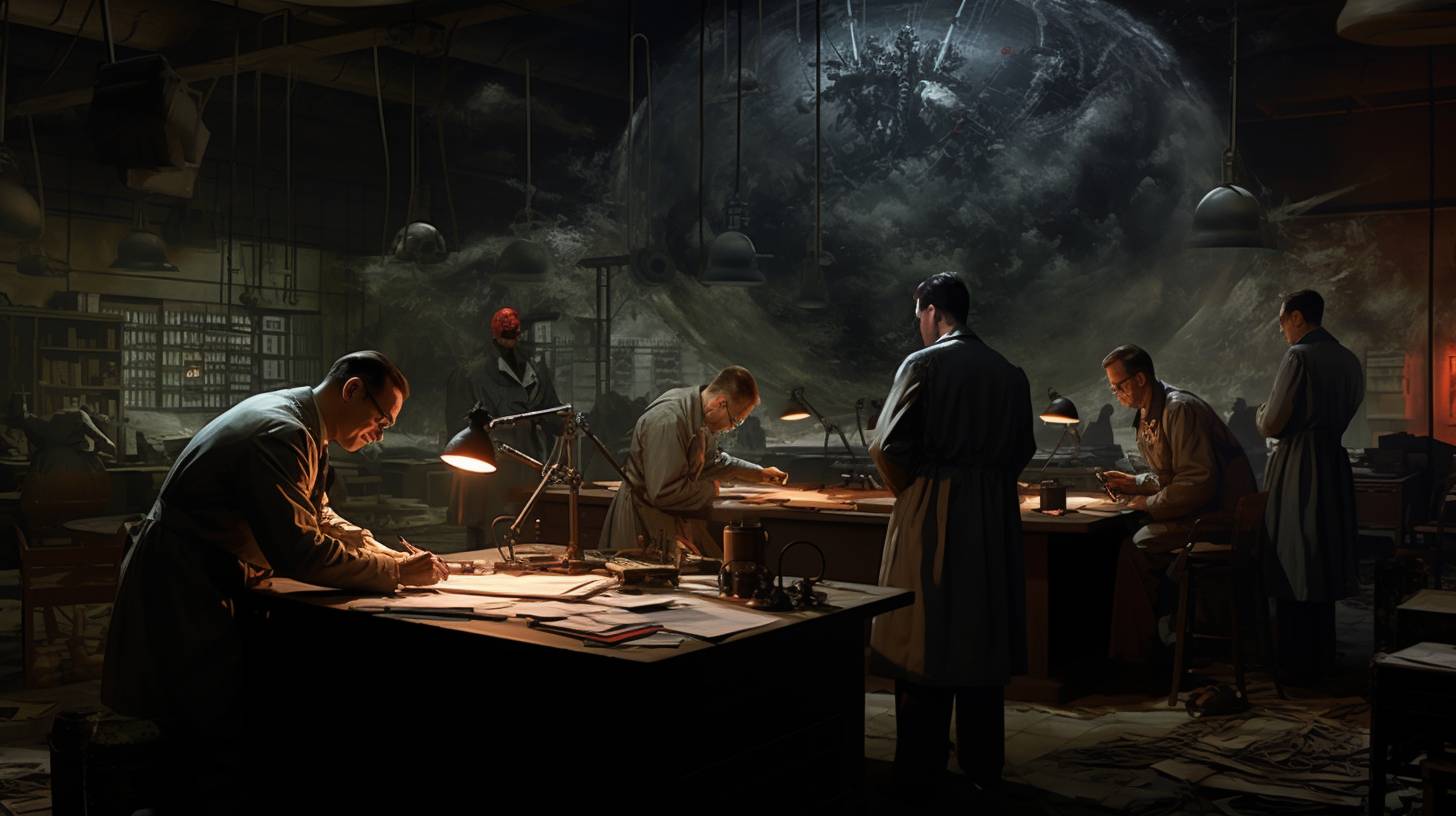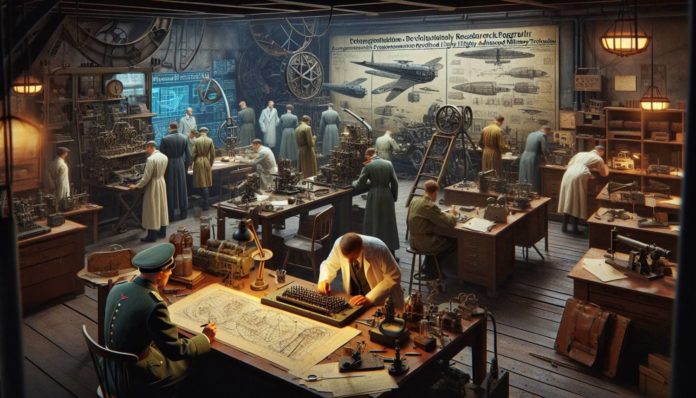The Second World War was a melting pot of innovations and technology, pushing the limits of what was technically possible in ways never imagined before. Among the significant contenders in this race was Nazi Germany’s “Wunderwaffe” program. Translated as “wonder weapons,” the Wunderwaffe was Hitler’s gambit, a series of advanced weapon systems intended to reverse the tides of war in favor of the Third Reich. These included a myriad of technologies, from rocketry and jet propulsion to experimental devices shrouded in secrecy and speculation.
This article will delve into the depth of Germany’s Wunderwaffe program, exploring the fascinating yet grim world of technological innovations that punctuated the Nazi era. From the well-known V-series weapons, including the unprecedented V-2 rocket, to the controversial and covert projects perpetuated in conspiracy theories — such as Die Glocke — we aim to shed light on the advancements made, their implications, and how they shaped the course of warfare and scientific progress in the aftermath of WWII. Join us through this journey as we unravel the truths, the myths, and everything in between.
Was The Wunderwaffe Program A Real Thing?

The Wunderwaffe program was indeed a real program that existed in Germany during World War 2. While there have been countless science fiction stories based on it, the foundation of the program lives on the truth. The idea was to develop technology so advanced and so devastating that it could single-handedly change the course of the war.
The Wunderwaffe program output several advanced weapons such as the V2-rocket but it also delved into more exotic and speculative technologies. There were plans for a “sun gun” that would focus sunlight onto enemy cities, a “wind cannon” that would blast aircraft out of the sky with compressed air, and even a “death ray” that would use electromagnetic radiation to destroy targets. However, these projects remained largely theoretical and never progressed beyond the drawing board.

In the end, the Wunderwaffe program was a mixed bag. On one hand, it produced some remarkable technological advancements that were far ahead of their time. On the other hand, it was a costly endeavor that diverted resources away from more practical and immediate needs. Furthermore, the program’s focus on “wonder weapons” may have led to an overreliance on technological solutions at the expense of sound military strategy.
Despite its shortcomings, the Wunderwaffe program remains a fascinating chapter in the history of World War II. It is a testament to the ingenuity and resourcefulness of German scientists and engineers, who were able to create groundbreaking technology under the most challenging of circumstances. At the same time, it serves as a cautionary tale about the dangers of placing too much faith in technological “silver bullets” to solve complex problems.
The Controversies Surrounding The Program
One of the primary controversies surrounding the Wunderwaffe program was its use of forced labor. Thousands of prisoners of war, concentration camp inmates, and other forced laborers were used in the production of these weapons. The conditions in which these individuals worked were often brutal, with many dying as a result of the harsh treatment they received. This aspect of the Wunderwaffe program has been widely condemned, and it remains a dark chapter in Germany’s history.
Another point of contention is the effectiveness of the Wunderwaffe program. While the weapons developed were technologically advanced for their time, many argue that they had little impact on the outcome of the war. The V-2 rocket, for example, was a marvel of engineering, capable of reaching altitudes of 189 km and speeds of up to 5,760 km/h. However, its accuracy was poor, and it was often more of a terror weapon than a strategic one. Similarly, the Me 262, while faster and more heavily armed than any Allied fighter, was produced too late and in too few numbers to make a significant difference.
The cost of the Wunderwaffe program is another source of controversy. The resources and manpower devoted to the development and production of these weapons were immense. Some argue that these resources would have been better spent on more conventional weapons and strategies that could have had a more immediate impact on the war effort. The V-2 rocket program alone is estimated to have cost twice as much as the Manhattan Project, which developed the atomic bomb.
Finally, there is the ethical question of the Wunderwaffe program. The development of these weapons was driven by a desire for a decisive, game-changing weapon that could bring about a swift end to the war. However, the use of such weapons, particularly the V-2 rocket, resulted in the deaths of thousands of civilians. This raises questions about the morality of developing and using such weapons, particularly in a war that was already marked by widespread atrocities.
In conclusion, Germany’s Wunderwaffe program was a significant part of World War II, but it is a part that is shrouded in controversy. The use of forced labor, the questionable effectiveness of the weapons, the immense cost of the program, and the ethical implications of the weapons developed all contribute to this controversy. Despite the technological advancements made, the Wunderwaffe program remains a contentious topic in the history of World War II.
Technological Innovations from The Wunderwaffe Program

The Wunderwaffe program was born out of desperation. As the war progressed, Germany found itself increasingly on the back foot, and the need for a game-changing weapon became more pressing. The program was a top-secret initiative, with the country’s best scientists and engineers working tirelessly to develop new technologies that could give Germany the upper hand.
One of the most famous products of the Wunderwaffe program was the V-2 rocket. This was the world’s first long-range guided ballistic missile, and it represented a significant step forward in rocket technology. The V-2 was capable of reaching an altitude of 189 miles and had a maximum range of 200 miles. It was used extensively in the latter stages of the war, causing significant damage to London and other cities.
Another notable innovation from the Wunderwaffe program was the Messerschmitt Me 262, the world’s first operational jet-powered fighter aircraft. The Me 262 was significantly faster than any Allied aircraft, and it had the potential to be a game-changer. However, production problems and fuel shortages meant that it was not deployed in significant numbers until the final months of the war, by which time it was too late to have a decisive impact.
The Wunderwaffe program also produced a number of other innovative technologies. These included the world’s first operational cruise missile, the V-1 flying bomb, and the world’s first submarine to use a snorkel, the Type XXI U-boat. The program also developed a number of experimental weapons, such as the Maus super-heavy tank and the Horten Ho 229, a prototype jet-powered flying wing that was decades ahead of its time.
However, despite these technological advancements, the Wunderwaffe program was ultimately a failure. Many of the weapons were too complex and expensive to produce in large numbers, and others were plagued by technical problems. Furthermore, the program was hampered by a lack of strategic direction, with resources being spread too thinly across too many projects.
In the end, the Wunderwaffe program was unable to deliver the decisive advantage that Germany needed. However, it did leave a lasting legacy. Many of the technologies developed by the program were years, if not decades, ahead of their time, and they laid the groundwork for many of the technological advancements that came after the war.
For example, the V-2 rocket was the precursor to the intercontinental ballistic missiles that would become a key part of the Cold War arms race. Similarly, the Me 262 was the forerunner of the jet fighters that would dominate the skies in the post-war era. Even the experimental weapons, such as the Horten Ho 229, have had a lasting impact, influencing the design of modern stealth aircraft.
The Impact of the Program on World War II
By 1943, Germany was losing on all fronts, and Adolf Hitler was looking for a miracle to reverse his fortunes. He turned to his scientists and engineers, tasking them with creating revolutionary weapons that could change the course of the war. The result was a series of projects that pushed the boundaries of what was technologically possible at the time.
Despite the technological achievements of the Wunderwaffe program, it ultimately failed to deliver the decisive advantage that Hitler had hoped for. The reasons for this are manifold. Firstly, many of the projects were plagued by technical problems, delays, and cost overruns. Secondly, the program was hampered by Hitler’s erratic decision-making and interference. He often changed his mind about which projects should be prioritized, leading to a lack of focus and wasted resources.
Moreover, the Wunderwaffe program was based on a flawed premise. Hitler believed that superior technology could compensate for Germany’s numerical inferiority, but this was a miscalculation. The Allies had superior numbers, better logistics, and a more coherent strategy. They were able to absorb the impact of Germany’s wonder weapons and still push forward to victory.
However, while the Wunderwaffe program did not change the outcome of World War II, it did have a lasting impact on warfare and technology. The V-2 rocket was the precursor to the intercontinental ballistic missiles of the Cold War, and the Me 262 laid the groundwork for the jet age. Moreover, many of the scientists and engineers who worked on the Wunderwaffe program were later recruited by the United States and the Soviet Union, where they played key roles in the space race and the development of nuclear weapons.
